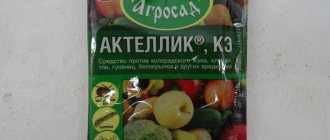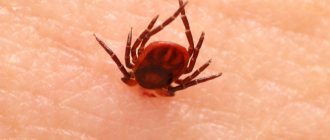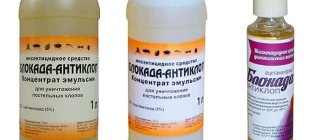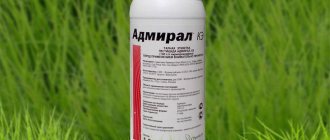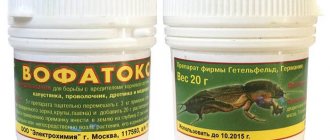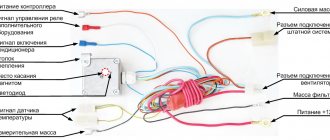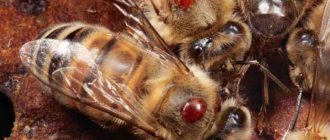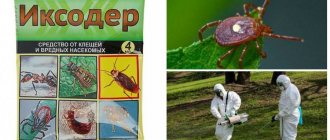Home / Preparations and fertilizers
Back
Published: 09/30/2020
4
Rate this post
Pests cause enormous damage to the crop, so the desire of summer residents to get rid of uninvited “guests” is quite understandable. Among the effective remedies is the drug “Actellik”, which is actively used in the garden and vegetable beds.
The chemical is widely known and gives excellent results.
IMPORTANT! Due to its high toxicity, it is currently permitted only for the treatment of greenhouses, as well as for the disinfection of storage facilities, basements, and cellars.
We understand the features of the product and the reasons for restrictions in use.
- 1 Description of the drug and mechanism of action
- 2 Purpose and scope
- 3 Advantages and disadvantages
- 4 Preparative form
- 5 Processing regulations
- 6 Analogs
- 7 Compatibility with other tools
- 8 Security measures
- 9 Useful tips
Description
Actellik is produced by the Swedish company Syngenta Crop Protection Co, which specializes in the production of plant care products for gardening.
Initially, Actellik was used to treat warehouses against pests, but later the range of its use expanded, and the drug became an indispensable assistant for gardeners.
The drug Actellik is characterized by an enteric contact action, provoking the death of plant pests through the penetration of the toxin through their integument and digestive system.
First aid
The recommendations below are intended only for providing FIRST aid, after which you should immediately consult a doctor and follow his instructions! DO NOT SELF-medicate!
- The victim should be taken out into fresh air at the first signs of poisoning: weakness, vomiting, nausea, malaise.
- If Actellik gets on the skin, remove the drug from the skin with cotton wool or a cloth, being careful not to rub it, and rinse this area of the body with running water or a weak soda solution.
- If Actellik gets into your eyes, you need to rinse them under running water for 15 minutes, keeping them open.
- If the drug has been swallowed, but the victim is conscious, you need to give him 5-6 tablets of activated charcoal with several glasses of warm water and induce vomiting. Attention! Do not induce vomiting if the victim is unconscious. You need to call a doctor and show him the drug label!
Actellik's antidote is the specific cholinesterase reactivator atropine sulfate, or P-2AM, but do not use it unless prescribed.
After providing first aid, consult a doctor immediately!
Action of the pesticide
The instructions for use state that pirimiphos-methyl is the active ingredient of Actellik. It belongs to FOS (phosphorgnate insecticides).
Contact of this substance with the parasite leads to complex intoxication, causing dysfunction of all internal organs. In addition to the high quality of external protection, the drug is also able to protect them from miners and their larvae.
Actellik CE is sold in the following volumes: for industrial agriculture – 1 liter and 5 liter canisters; for personal households - in ampoules of 2 ml and 5 ml, and bottles of 50 ml and 100 ml.
Reviews
Vasiliev: The drug has proven itself as a remedy against stock pests. I managed where other pesticides failed. It’s a pity that Actellik is still a bit expensive, but sometimes you pay more for worse quality, so it’s a shame to complain.
Seluyanov: an excellent drug, very effective against literally all pests both in the greenhouse and in flower beds. And after treating the indoor flowers, the smell disappeared quite quickly. But the price is steep.
Anna: Actellik helped me cope with mealybugs on indoor plants. True, I almost suffocated because I carried out the treatment in the bathroom. Next time I will do it on the balcony.
Maryana: I brought a sofa from a friend and after a while I discovered that it was infested with bedbugs. I don’t know what I would have done if it weren’t for Actellik. I treated the sofa, locked the room and did not enter it for a week, and when I moved the sofa away from the wall, I discovered more than a hundred dead parasites.
- How to use green soap for illnesses
Evgeniya: the drug, of course, is deadly, but I won’t use it in the apartment anymore. For indoor plants I’ll look for something less smelly, but in the garden you can use Actellik: the drug is strong, one spray is enough to kill all the pests.
Official website and manufacturer's recommendations: https://www.syngenta.ru/products-crop-protection-insecticides
Terms of use
Actellik treatment is carried out during dry and windless weather. Temperature – less than 25 oС. The dosage depends on the size of the infested area, the type of plant and soil. The proportion of material consumed is as follows:
- Vegetable crops (pepper, tomato, zucchini, etc.): initial proportionality – 2 ml of pesticide per 0.7 liter of liquid. For open soil – 2 liters of working solution per 10 m2 of area. For closed - 1 liter of working solution per 10 m2. Seasonal treatment is carried out twice at weekly intervals.
- Berry crops (raspberries, strawberries, etc.): the proportion of pesticide and water is 2 ml per 1.4 l, respectively. If grapes, melon or watermelon are processed, then the proportionality changes - 2 ml of Actellik per 0.7 liter of liquid. For open soil – 1.5 liters of solution per 10 m2.
- Fruit trees (apple, pear, plum, etc.): solution dosage – 1 ml of pesticide per 1 liter of liquid.
- Ornamental open ground plants (thuja, conifers, etc.): the proportion of pesticide and liquid is 2 ml per 1 liter, respectively.
- Warehouses and barns: treatment is carried out 3-4 weeks before storage after thorough cleaning. Proportion – 16 ml of chemical per 0.8-1 liter of water. To process 1 ton of grain stocks, 1 liter of solution is used.
Important! Treatment of decorative indoor plants is carried out outside the living space, as the drug is toxic. Fitoverm will be an excellent replacement for Actellik for indoor plants.
Content
- Purpose and application
- Composition and dosage form
- Mechanism of action
- Application regulations
- a) Application of “Aktellik, CE” on vegetable crops in protected soil
- b) Application of “Aktellik, CE” for disinsection of storage facilities
- c) Application of “Aktellik, CE” for grain protection
- Restrictions and security
- Compatibility
- Analogs of the drug "Actellik"
- Advantages and disadvantages of application
Actellik is an effective pesticide for protecting plants and grain reserves. The material contains the purpose, composition, release format, regulations for use, compatibility, analogues, restrictions, etc.
Storage
Actellik's shelf life is 3 years. Keep it in a dry place, storage temperature – 0-35 oC. The solution itself cannot be stored, so it must be used immediately after preparation. Disposal of residual material and empty containers is carried out in accordance with regulations.
Medicines for spider mites
Before you run to specialized stores selling pest control products, you should understand that there are two types of drugs: chemical and biological.
Read also: Tea leaves as fertilizer for flowers
Chemical preparations have an acaricidal effect and can be used only to exterminate spider mites, or they can be used for a wide range of purposes – against various indoor pests.
Drugs containing chemical compounds come in varying degrees of toxicity.
For a room, they usually use products belonging to the 3rd class, but the previous two in the middle of the room should absolutely not be used, since people, animals, and fish can be poisoned. Sometimes spraying of poison is carried out near the house. After the smell has completely disappeared, the pot with the plant can be brought back.
When processing with chemicals, you should follow some rules:
- Plants should be irrigated frequently to avoid dry “islands.”
- Processing consists of 3 stages. After the first treatment of the plant, at least 5 days should pass, after the second - another 5 days.
- Only dry plants need to be treated.
- If you use one drug for a long time, it needs to be replaced with another (with a different active ingredient).
- Tick destruction takes up to 12 hours. The air temperature should be no lower than 20º and no higher than 26º Celsius.
- Don't forget about the soil in the pots - you need to pour a little solution into it.
- It is mandatory to have protective equipment for those carrying out the processing.
The action of biological preparations is based on the active intervention of living microorganisms in the usual life of the spider mite.
This method of exterminating the pest is especially popular among those who breed a large number of indoor plants for sale. Either a special mushroom or a predatory insect is added to the plants, which will simply feed on spider mites. The disadvantage of this method is that the storage of the “killer material” is short-lived.
Recommendations for use
The instructions for use contain clear safety instructions when using the chemical:
- To prepare the solution, you must use special containers and also use personal protective equipment.
- Avoid contact with mucous membranes.
- The total time of working with the chemical should not exceed 2 hours.
- Visiting treated greenhouses, barns and warehouses is not allowed for 3 days.
- Upon completion of work, it is necessary to thoroughly wash personal protective equipment, as well as the face and hands with soap.
Instructions for use and consumption rates for indoor plants
Instructions for use are the same as for garden plants. Only treat indoor plants on the balcony or in the fresh air, but under no circumstances indoors. And if you need to treat office plants, then you need to do it on weekends so that there are no people in the office.
For prevention, it will be enough to spray your plants once, but to combat various pests, the treatment will need to be repeated after 1-1.5 weeks.
From time to time, Actellik is replaced with other solutions of the same type, so that there is no addiction or to destroy surviving pests.
Analogues of Actellik and its compatibility
Analogues of Actellik can be: Vermitek, Iskra, Fitoverm, etc.
Actellik can be freely combined with similar insectoacaricides. In case of additional treatment after the end of the protective period, it is advisable to use Actellik simultaneously with Aktara or Vermitec.
The chemical has a low level of persistence, so it can be combined with biological products without any problems. An exception applies to wettable powders, dust, Bordeaux mixture and alkaline preparations.
Types of spider mites
This species does not belong to the mite family, but is a member of the arachnid group. This is important, because in order to choose the right means for its elimination, you need to understand which drugs are suitable for dealing with this particular category of pests.
Description, biological characteristics
- Belongs to the class of arthropods, not insects;
- The size of the individual is about half a millimeter, and it can only be seen using a magnifying glass;
- Life time is 25-35 days, but during this period each female lays several hundred eggs, from which new individuals emerge after 3 days. After just a few days, they are ready for the process of increasing the population through reproduction. Eggs do not lose viability for about 5 -10 years. 20 generations of individuals are formed per year;
- The color may be brown or brown. The female is colored reddish, so it is much easier to distinguish her on the leaves;
- The body is oblong, covered with villi;
- They live in colonies on the underside of the leaf, and with the arrival of winter they can go deep into the soil up to 22 cm;
- During diapause, they crawl into cracks in window sills, under baseboards, chipped pots, and into recesses in window frames.
Certain varieties of mites choose different flowers and plants, and their attacks on them are widespread.
| Type of tick | Plants |
| Gossamer common | Fuchsia, balsam, ficus, roses. |
| Red | Roses, all types of orchids, nightshade, lemon, azalea, camellia, cacti, carnations, callas. |
| False | Citrus fruits, orchids, passionflower. |
| Atlantic | Palm, ficus. |
| Cyclamen | Chrysanthemum, cyclamen, pelargonium, balsam, violet, dahlia, geranium, daisy, petunia, azalea. |
| Wide | Anthurium, euonymus, ficus, oleander, cactus. |
| Clover | Ficus, orchids, all bulbous. |
| Wide | Impatiens, hibiscus, dahlia, begonia, cyclamen, chrysanthemum. |
Almost all types of these pests are omnivorous, but there are exceptions; plants with a fleecy surface and all varieties of aloe are not so often affected.
You can especially often see its population on roses and orchids; many gardeners, after an unsuccessful struggle, stop growing them.
They not only destroy the plant, but also carry various fungal diseases.
If the damage to the specimen is strong enough, then it is better to destroy it as quickly as possible.
Advantages and disadvantages
- Advantages - The scope of use of the chemical is quite wide. Highly effective. Characterized by high duration and speed of action. Easy to use. Protects against a complex of leaf-eating and sucking plant pests.
- Disadvantages - Toxic. Unstable in both acidic and alkaline environments. Repeated treatment leads to resistance. Not suitable for prophylaxis. Cannot be used at home. Cost of processing open soil plants.
How to detect spider mites
One of the important rules for its destruction is regular and thorough inspection of the plant.
There are certain symptoms and external signs that it is affected by this pest:
- Discolored spots on the undersides of leaves;
- The dots on the underside of the leaves are either dark or faded;
- Punctures on leaves (initial stage);
- Thin colorless cobweb;
- Loss of green color of the leaf, it turns red, a marble tint appears;
- The leaves begin to dry, become deformed, and curl;
- White coating on various parts in the form of dandruff;
- Layer of “dust”;
- Slow growth;
- Accumulation of pests on the edges of leaves (with large lesions).
For inspection, it is better to use a magnifying glass and conduct it in daylight.
Unfavorable environmental factors for this pest are: cold, high humidity (more than 55%) and cool temperature (less than 25 degrees Celsius).
But even under such conditions, there is no guaranteed death of pests, because they have the biological ability to slow down all processes of their life (diapause).
During such a period, they seem to freeze without signs of life, stop moving, do not drink the juice of the leaves, and one might think that the fight with them ended in victory. But when conditions suitable for them are restored, their attacks on plants resume with even greater force.
How to properly treat indoor flowers with medications
Spider mites are quite a serious problem and their destruction requires methodicality and the correct implementation of all stages. It is not possible to easily eliminate such a quickly spreading pest, so a number of important rules must be followed.
Processing rules
- First of all, it is necessary to immediately destroy those specimens that are 80-90% damaged by the pest, since it is better to lose one or two than the entire home collection;
- All damaged leaves must be torn off and destroyed;
- All plants must be disinfected, regardless of the presence of a pest;
- It is necessary to disinfect window sills, baseboards, window structures, pallets, and the outer parts of pots with alcohol; you can use a strong solution made from laundry soap;
- Wash the curtains in the room and bathroom if disinfection measures were carried out there;
- It is advisable to carry out the elimination of the population in the first half of the day in daylight;
- Before processing, wash the plant in the shower with a solution of soap flakes. For plants for which “water procedures” are undesirable, prepare a steam bath by turning on hot water (the drain is not closed).
- Practitioners - flower growers do not recommend using such a solution; it turns out that it clogs the stomata on the leaves, thanks to which the plant breathes;
- The plant must be dried before processing.
The process involves spraying the trunk and the entire surface of the leaves on both sides with the selected preparation, and it is spilled so that the plant is completely wet. The soil mixture in the pot is also treated.
Place a food grade polyethylene bag over the plant and leave it for 1-2 days.
Small indoor crops can be treated by immersing them, crown down, in a container with a solution of the product.
If the spraying method is not suitable for the plant, use a cotton swab soaked in the preparation, which is placed on the ground in a pot and also covered with a plastic bag.
It is important to start the treatment process as early as possible, at the first signs of the presence of the pest.
In what cases is it used
An important advantage of the insectoacaricide Actellik is a wide range of pests that die due to the use of the enteric contact agent of the FOS group. An important point is the destruction of ticks and insects after treatment.
The following are sensitive to the action of pirimiphos-methyl:
- whitefly;
- scale insect;
- spider mite;
- cabbage scoop;
- fungus gnats;
- Colorado beetle;
- weevil;
- tea moth;
- flower beetles;
- aphid;
- thrips and other pests.
Emulsion concentrate and wettable powder are used:
- for the destruction of garden and vegetable pests, insects and mites that have settled in the greenhouse, greenhouse, and indoor flowers;
- for preventive purposes: to protect plants of all listed groups from attack by pests.
Prevention of spider mites
Preventative measures play an important role in protecting your indoor greenhouse from spider mites. It can enter the house along with the air from the street, when buying soil, a new plant, even with a gift bouquet.
Therefore, it is necessary to take preventive measures to prevent the pest from establishing itself in your indoor garden.
- Regular inspection of plants for the presence of adult pests, their larvae and eggs;
- Weekly shower with warm water, temperatures up to 43 degrees are permissible, since the pest does not tolerate humidity and is easily washed off from the leaves;
- Regulate the level of humidity in the room to create uncomfortable conditions for tick life. You can use air humidifiers, climate control devices;
- in summer it is good to take them out onto balconies and terraces for ventilation and exposure to sunlight;
- “Clean” the plant from weeds, dried and fallen leaves;
- Ultraviolet irradiation at least once a month;
- Any new plant must be quarantined for 2-3 weeks.
Quarantine measures for a new plant should include a mandatory shower immediately after purchase and treatment with one of the products aimed at destroying possible pests. After treatment, it is covered with a bag and removed no earlier than after 2 days. This needs to be repeated again. The soil and drainage of the new “pet” must be disinfected.
The plant is placed in a separate room, without contact with other specimens; contact is not allowed.
Spider mites can return even after the most thorough measures to destroy them, so it is necessary to constantly keep your flowering garden under control.
“>
Biological measures against spider mites
The essence of biological control methods is that the destruction of the pest occurs naturally, without the use of chemicals or folk remedies, but with the help of their natural enemies. For this purpose, bioagents are used: predatory mites - phytoseiulus, metaseiulus, amblyseius and predatory bugs - macrolophus. They can usually be purchased in specialized stores.
Most often, such methods are used in industrial greenhouses and flower greenhouses. They are used less frequently for indoor floriculture, although the results are quite impressive: one predator can eat 5 mites or 10 eggs per day. Research work on the use of bioagents to destroy this group of pests is being carried out in some European countries and is considered a promising direction.
